Serviços Personalizados
Journal
Artigo
Indicadores
-
 Citado por SciELO
Citado por SciELO -
 Acessos
Acessos
Links relacionados
-
 Citado por Google
Citado por Google -
 Similares em
SciELO
Similares em
SciELO -
 Similares em Google
Similares em Google
Compartilhar
Earth Sciences Research Journal
versão impressa ISSN 1794-6190
Earth Sci. Res. J. v.11 n.1 Bogotá jan./jun. 2007
PALEONTOLOGICAL STUDY OF THE ECHINODERMS IN THE QOM FORMATION
(CENTRAL IRAN)
Keyvan Khaksar1, Iraj Maghfouri Moghadam2
1 Islamic Azad University, Qom, Iran. E-mail:k1khaksar@yahoo.com
2 Lorestan University, khorram- Abad, Iran. E-mail:Irajmmms@yahoo.co.uk
Manuscript received December 15 2006. Accepted for publication June 10 2007.
ABSTRACT
The Qom formation was formed in the Oligo-Miocene during the final sea transgression in Central Iran (Figure 1). The best outcrop is located in the vicinities of the Qom City, approximately 130 km at the south of Tehran. In general, the great heights of the zone are the result of intense tectonic activities. These heights have a number of faults and folds. Echinoderms are one of the most important and numerous fossil groups present in the Qom Formation and confirm the relationship of this environment with free waters. In the present investigation more than 100 prepared samples were studied and 17 species were identified, scanned and classified. These fossils are more abundant in the upper part of the A member, which illustrates the abundance and diversity in C1 and C3 sub-members belonging to the C member. To classify these samples, classical and up-to-date methods were used. However, the systematic schemes were used more frequently (Moore, 1966; 1969-1971).
Besides these studies, the other concomitant microfossils in the formation were investigated simultaneously to estimate the accurate age of them. It is concluded that the study of Oligo-Miocene Echinoderms present in the Qom formation is essential and important because, at the same time, the Central Iran Sea had a communicative role between the Indo-Pacific Ocean and the Mediterranean Sea.
Key words: Central Iran, Oligo-Miocene, Limestones, Echinoderms.
RESUMEN
La Formación Qom se formó durante el Oligoceno-Mioceno durante la transgresión final del Mar en Irán Central (Figura 1). El mejor afloramiento se encuentra localizado en los alrededores de la ciudad de Qom, aproximadamente a 130 km al sur de Teherán. En general, los altos pronunciados de la zona son el resultado de la intensa actividad tectónica. Estos altos poseen un gran número de fallas y pliegues. Los Equinodermos son los fósiles más importantes y numerosos que se encuentran en la Formación Qom y confirman la relación de este ambiente con el agua. En la presente investigación más de 100 muestras fueron preparadas y estudiadas, y de las mismas se identificaron y clasificaron17 especies. Esto fósiles son más abundantes en la parte superior del miembro A, el cual ilustra la abundancia y diversidad en los sub-miembros C1 y C3 pertenecientes al miembro C. Estas muestras fueron clasificadas por medio de los métodos recientes y clásicos. Sin embargo, los esquemas sistemáticos fueron usados con más frecuencia (Moore, 1966; 1969-1971).
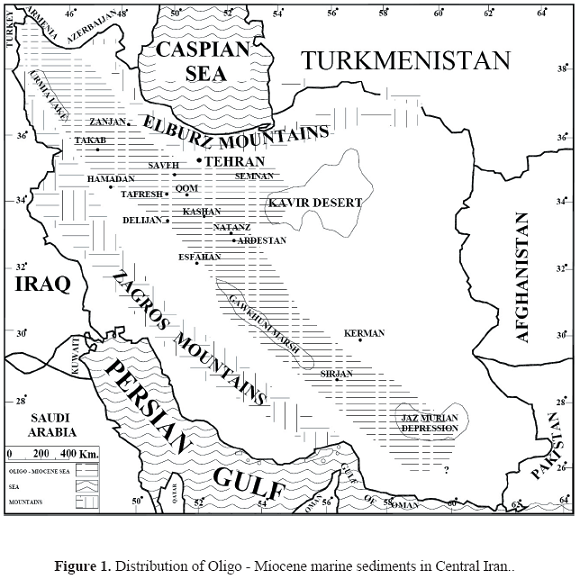
Aparte de estos estudios, los otros microfósiles concomitantes en la formación fueron investigados simultáneamente para estimar su edad exacta. Se concluyo que el estudio de los Equinodermos del Oligoceno-Mioceno presentes en la Formación Qom es esencial e importante porque, al mismo tiempo, el mar de Irán Central permitía la comunicaión entre el océano Indo-Pacífico y el mar Mediterráneo.
Palabras Clave: Irán Central, Oligo-Mioceno, Calizas, Equinodermos.
INTRODUCTION
The Marine Qom Formation was deposited in the Oligo-Miocene and is the result of the last transgression of the sea in Central Iran. The formation contains five members containing limestone interstratified with marlstone and deposited during three sedimentary cycles. The mean thickness of this formation is approximately 900 meters in the vicinities of the Qom City. This formation consists of the following five members (Figure 2):
A Member
The A Member has an average thickness of 55 meters and the thickness of its beds varies between 2 and 200 cm. This member contains several parts starting from the base:
* Limestones with muddy texture without fossils. * Limestones (packstone) containing benthonic foraminifera. * Limestones (grainstone) containing oolits and bioclasts. * Limestones (packstone) with foraminifers, bryozoans, red algae, gastropods, bivalves, and echinoderms. * Sandstones with glauconite containing remnants of complete echinoderms, bryozoans, and sedimentary structures such as cross-bedding.
B Member
It is composed by 225 meters of thick layers of sandy marlstones and sandstones intercalations (with cross-bedding) and containing glauconite, which is the cause of the green colour of marlstones. The fossils commonly observed in this part are benthonic and planktonic foraminifers.
C Member
The C Member has an average thickness of 370 meters and has the following sub-members:
C1: Composed by marlstones interstratified with limestones. The thickness of the bed is between 10 and 200 cm. The limestones have the following texture starting from the base:
* Packstone with abundant fossil assemblages of echinoderms, bivalves, bryozoans, red algae, gastropods, and corals. * Boundstone containing bryozoans, corals, and red algae.
C2: C2 illustrates the termination of the primary sedimentary cycle. It contains the following textures:
* Mudstones with plenty of organic materials. * Layers of gypsum.
C3: This sub-member is composed by limestones. The thickness of the bed is between 5 and 300 cm and composed by the following textures starting from the base:
* Grainstone containing oolits, bioclasts, and sedimentary structures such as crossbedding. * Packstone and boundstone with echinoderms, corals, bryozoans, and red algae. * Packstone with shell fragments of bivalves and foraminifers.
C4: Composed by marlstones containing foraminifers, corals, and internal moulds of gastropods. Catapsydrax stainforthi BOLLI, LOEBLICH, and TAPPAN are also found in thissub-member belonging to Burdigalian.
D Member
This member illustrates the Qom Formation's second termination cycle and consists of 22 meters thick layers of gypsum.
E Member
It is composed by 230 meters of thick layers of marlstone intercalated with limestone. The fossils commonly observed are: foraminifers, red algae, gastropods, bivalves, and bryozoans, with following textures (limestone) from the base:
* Packstone with bryozoans, red algae, gastropods, and corals * Boundstone containing stromatolites, corals, and bivalves * Grainstone containing bivalves, red algae, and benthonic foraminifers.
BIOSTRATIGRAPHY
Because of macro and microfossils of the Qom Formation such as Globorotalia (Turborotalia) opima opima BOLLI present in the member B and Catapsydrax stainforthi present in the C member. This formation has been known chronologically.
Figure 3 shows the vertical distribution of echinoderms. The existence of some Echinoderms, Echinodiscus balestrai and Clipeaster folium MICHELIN, in the lower part of the formation gives it an age of Medium-Superior Oligocene.
The decrease in the number of Echinoderms towards the upper part of the formation is due to the great migration of these species towardsthe North in Burdigalian sup. because Earth's temperature was generally high in Burdidaliense (Demarcq, 1984). However, the temperature in Burdigalian sup. rose even further (Flower and Kennet, 1994).
TAPHONOMY
In several places of Central Iran, the layers are steeps because of folding and tectonic activities, and it takes a long time to identify top and bottom sedimentation layers. In these cases, the presence of echinoderms is one of the best criteria to recognize the polarity and also reflects a calm sedimentary environment.
Sometimes, it could be observed that the layers, exclusively composed by this genus of echinoderms (Scutella and Clypeaster), are already erosive. This can be seen in sandstones of the upper member A and sub-member C1. These layers demonstrate turbulent movements at the bottom of the sea. This secondary echinoderm accumulation illustrates the periodic sea storm, which causes erosion of fine sediments and echinoderm fragment accumulation (Figure 4).
Due to the irregular base of the layers, each bed could be originated from remaining sediments (lag) of turbulent sea beds, demonstrating a transgressive phenomenon in the sedimentary basin.
GEOLOGICAL SETTING
The Qom province is part of the Central Iran zone, in which sub-parallel mountain ranges and plains have general northwest-southeast trend.
The North-western plain is the terminal part of the Qom-Ardekan depression, divided into two parts by the small hills of the Koshk-e-Nosrat heights located to the north of the Howz-e- Soltan Lake. The Central parts of the province have hillocky topography, while the western and southwestern parts are mountain regions belonging to the Urumiyeh-Bazman volcanic belt, with some summits up to 3000 meters.
The oldest known rocks of this province are of Eocene age, which are younger volcanic rocks exposed in western parts of this province and belong to the Urumiyeh-Bazman volcanic belt. These magmatic rocks can be divided into three zones: Ashtian-Naragh, Tafresh and Saveh. The Tafresh member has a central position with respect to Ashtian-Naragh (south) and Saveh (north) members. This part is characterized by an important sedimentation and subsidence while the Saveh member is characterized by important Upper Eocene magmatic activity, and the Ashtian-Naragh member is featured by its high volcanic activities of the Neogene.
Orogenic movements in the Late Eocene-Early Oligocene resulted in the creation of lagoonal to continental sedimentary regime characterized by detritic-evaporitic sediments of the Lower Red formation. Local and lateral facies changes are all related to inherited local changes of topography. Lagoonal evaporites of rather considerable thickness represent high rate of subsidence in this continental environment (Tehrani, 1989).
Oligo-Miocene carbonates of the Qom formation represent marine transgressions in this province with marly-calcareous sedimentation. Duringthis period volcanic activities continued locally, represented by analcite bearing basanite and andesites. In the Late Miocene, thick lagoonalcontinental deposits of Upper Red formation were replaced by the marine Qom formation with two distinct Neogene volcanic activities (Bozorgnia, 1965).
Pliocene sequences of Qom formation have various facies. They are comprised by three volcanic-subvolcanic, volcanic-sedimentary and detritical units. Plutonic igneous bodies, which intrude into the Urumiyeh-Bazman volcanic rock, are other characteristical feature of the Qom province. These intrusive bodies have definitively a conspicuous relation with fracture zones. The intrusive bodies are either extensive or small.
The Qom province is still an active tectonic environment materialized by active seismicity. The late movements, with general direction of north-northeast compression, configure the actual structural feature of this province.
PALEOGEOGRAPHY
Considering the results of the present study and those of the previous works in the Oligo- Miocene outcrops in different regions of Iran and their environments, it is attempted here to reconstruct the paleogeography of this region. As a result of the tectonic movements of the upper Cretaceous and the rise of Northern region of the Alborz (Tehrani, 1989), two different sedimentary basins have been formed: one in the North of the Alborz (Pentocaspiana basin) that is situated in the present zone of the Caspian Sea,and the other is located in the Southern part of the same mountain range (in Central Iran). In central Iran, the Eocene and Lower Oligocene are characterized by continental sediments (Lower Red Formation). The basal contact of the transgressive deposits of Oligo-Miocene age with the L.R.F. is marked in many zones by an angular discordance that indicates the influence of the tectonics movements before the marine transgression (Bozorgnia, 1965).
During the Oligocene (Chattian) a great channel connecting the Mediterranean and the dominion Indian-Pacific through the South of Iran was formed, separating Africa and Euro-Asia. In the Miocene (Burdigalian), rotations and vertical and horizontal movements of the Lut block and Arabian plate, and the impact between the latter with Turkey, caused the interruption of connection between the Mediterranean and the Indian Ocean during the Burdigalian (Steininger and Rogl, 1984). The sea invaded a part of Turkey (Adana and Karaman), where the outcrops are formed generally by limestones with Lithothamnium. In Syria, the deposits of the Burdigalian have high contents in Pecten, Clypeaster, and macroforaminifers. The extension of these deposits covers a large area of Syria and from Mesopotamia to Iraq, and from there to the Persian Gulf. These indicate that a sea passage existed between the Mediterranean and the Indian Ocean. This channel was interrupted in the upper Burdigalian because of the orogenic movements that affected the Mediterranean coasts and Iraq. In the northern zone of the Mediterranean, the Rzehakia (Oncophora, Bivalvia) marine series, containing molluscs of the Burdigalian, are extended from Switzerland to the Aral Sea. They are attributed to shallow basins, which are isolated and interconnected by a partial connection with the open sea and influenced by continental environments. The Langhian is characterized by great geodynamical instability and a sediment substitution of the shallow marine condition by continental sediments in the Arabian plate and Mesopotamia (Buchbinder and Gvirtzman, 1976). The last marine regression took place during the Langhian in central Iran.
PALEOCLIMATOLOGY
Skeletal and non skeletal sediment particles were studied and could be summarized as follows:
SKELETAL PARTICLES
The large number of fauna such as corals and macroforaminifers in upper parts of the C and E Members indicate high temperatures. Macroforaminifers in the Qom Formation such as Operculina, Miogypsina, Miogypsinoidi, Lepidocyclina, Heterostegina, Amphistegina, and Spiroclypeus are representative of warm sea environments (Boltovskoy and Wright, 1976; Allasinaz, 1983; Demarcq, 1984; Lauriat et al., 1993).
The presence of Rotalia viennoti and Borelis in limestones illustrates tropical climates (Delanoe et al., 1976; Lauriat et al., 1993). The Presence of Red Algae (Lithophylum, Mesophyllum, Sporolithonn, and Lithothamnium) also represents tropical climate (Bosence, 1983).
Macrofossils such as Scutella, Clypeaster, Echinolampas, Amphiope, and Maretia represent warm waters. Maretia is an indicator of tropical climates, as observed in the Indian and Pacific domains (Llompart, 1983; Lauriat et al., 1993). The presence of bio-constructions and hermatipic corals in several layers (e.g., upper layers of the C1 submember) confirms that the temperature ranged from 18o to 30oC (Minnery et al., 1985). The presence of bivalves such as Amusium and Spondylus is representative of warm sea environments (Demarcq, 1979; Turek et al., 1988).
NON-SKELETAL PARTICLES
These particles such as oolits indicate warm and dry climates belonging to sea environments where evaporation exceeds rainfall (Reijers et al., 1983; Zeng et al., 1983).
Oolits are formed at temperatures above 15oC and minimum salt content of 36 percent (Lees, 1975). It seems that after the cold Lower-Oligocene, the temperature in the Superior-Oligocene increased, reaching its optimal temperature in the Burdigalian. Then, the temperature suffers a sudden decrease in the Middle Miocene (Demarcq and Pouyet, 1990).
In conclusion, it could be understood that the sediments of the Qom Formation were formed in tropical and subtropical environments.
CONCLUSIONS
* Firstly, the presence of Echinoderms in the Qom Formation reveals a passage to the sea.
* The presence of Echinoderms in the Qom Formation is one of the best criteria to recognize polarity and also reflects a calm sedimentary environment.
* The presence of the Echinodiscus balestrai OPPEN and Clipeaster folium MICHELIN in the base of formation verifies the age of Middle and Upper Oligocene in these sediments.
* The recognized genus in this formation represents warm waters.
* The most important and abundant echinoderms are Scutella and Clypeaster belonging to the coastal regions and their morphologies indicate energetic environments.
* As mentioned in the A member, especially for the upper sandstones and the C1 submember, there are layers containing echinoderms.
* This concentration may relate to storms and turbulence in the sea bed.
* Occasionally and concurrent with the formation of layers of Scutella, the content of glauconite increased in the sandstones.
* This event corresponds to an increase of the depth of the sea and illustrates a transgressive case. In the upper part (B Member), the sediments changed to sandy marls containing planktonic foraminifers and glauconite as a result of the transgression.
* Their abundance of echinoderms and variation decreased in upper parts of the formation. This could be attributed to higher temperature in the upper Burdigalian, resulting in their migration from Central Iran.
* After the sudden drop of temperature in the Lower Oligocene, the global temperature began to increase. The Burdigalian had a warm climate and the temperature increased even further in the upper Burdigalian.
* The presence of corals and foraminifer fossils represents warm climates.
SYSTEMATIC
Class ECHINODERMATA
Subclass Euechinoidea
Superorder Gnathostomata
Order Clypeasteroida
Suborder Clypeasterina
Family Clypeasteridae
Genus Clypeaster LAMARCK, 1801
Clypeaster aff. scillae DESMOULINS
Pl.1, fig.1
1837 Clypeaster scillae DESMOULINS, p.64.
1901 Clypeaster crassicostatus, AIRAGHI, p.35, Pl.II/5, IV/1
1958 Clypeaster scillae, SMEDILE, p.35, Pl.III/3
1966 Clypeaster scillae, MOORE, p.462
1984 Clypeaster scillae, DEMARCQ, Pl.XII/1
Material - 9 Samples Distribution - Miocene inferior of almost all studied profiles.
Clypeaster aff. folium MICHELIN
Pl.3, fig.2
1859 Clypeaster folium MICHELIN, Pl.XX/2
1915 Clypeaster martini COTTREAU, p.98, Pl.XI/1-4
1920 Clypeaster marginatus ginatus FORTEAU, Vol.2
1958 Clypeaster folium, SMEDILE, p.32, Pl.XI/3
Material - 1 Sample
Distribution - Oligocene of Dochah
Clypeaster biarritzensis COTT. var. trotteri GREGORY
Pl.6, fig.2
1891 Clypeaster biarritzensis COTTEAU, II, p.229
1911 Clypeaster biarritzensis var. trotteri GREGORY. p.662, Pl.XLVII/1
1913 Clypeaster biarritzensis var. trotteri, FABIANI y STEFANINI, p.78
1921 Clypeaster biarritzensis var. trotteri, STEFAN. p.126, Pl.XVII/7
Material - 1 Sample
Distribution - Oligocene of Shurab.
Suborder Scutellina
Superfamily Scutellidea
Family Scutellidae
Genus Scutella LAMARCK, 1816
Scutella subrotundus (LESKE)
Pl.2, fig.1
1841 Echinodiscus subrotundus LESKE (1778) en AGASSIZ, p.5
1917 ? Lambertiella CHECCHIA- RISPOLI, p.57
1966 Scutella subrotunda, MOORE, p.477, fig.366/1 1981 Scutella subrotunda, KALANTARI, Pl.61/1-4
Material - 9 Samples
Distribution - Oligocene and Miocene inferior of almost all the profiles.
Family Astriclypeidae
Genus Echinodiscus LESKE, 1778
Echinodiscus balestrai OPPENH
Pl.3, fig.3
1939 Echinodiscus balestrai, STEFANINI, p.127
Material - 2 Samples
Distribution - Oligocene of Bichareh and Dochah.
Genus Amphiope AGASSIZ, 1840
Amphiope bioculata (DESMOULINS)
Pl.3, fig.4
1815 Scutella bifora var.3 LAMARCK, p.10, n7؛ 1837 Scutella bioculata var. A tipus DESMOULINS, p.232, n23
1906 Amphiope bioculata, LAMBERT, p.50 1948 Amphiope bioculata, MORTENSEN, p.413, fig.243
1966 Amphiope bioculata, MOORE, p.489, fig.374/1 1983 Amphiope bioculato, LIOMPART, p.70, Pl.1-3
Material - 1 Sample
Distribution - Burdigalian of Eidajti.
Superorder Atelostomata
Order Cassiduloida
Family Echinolampadidae
Genus Echinolampas GRAY, 1825
Echinolampas cfr. vilanovae COTTEAU Pl.4, fig.1
1890 Echinolampas vilanovae COTTEAU, p.73, Pl.IX/1-5
1981 Echinolampas cfr. vilanovae, KALANTARI, Pl.63/1-2
Material - 14 Samples
Distribution - Burdigalian the Kamar Kuh, Navab, Eidajti, Bichareh.
Echinolampas (Macrolampas) discus DESOR
Pl.5, fig.1
1858 Echinolampas discus DESOR, Synopsis, p.307
1877 Echinolampas discus, DAMES, Echiniden. p.43, Pl.III/1
1919 Echinolampas discus, STEFANINI, II, p.17 1935 Echinolampas (Macrolampas) discus, VENZO, p.230, Pl.XIX/2,3
Material - 8 Samples
Distribution - Miocene inferior of the central part of the basin.
Superorder Echinacea
Order Echinoida
Family Echinidae
Genus Psammechinus AGASSIZ y DESOR, 1846
Psammechinus affinis FUCHS
Pl.7, Fig.2.
1972 Psammechinus affinis, NAINI. p.223, fig.77,78
1981 Psammechinus affinis, KALANTARI, Pl.63/3-5
Material - 3 Samples
Distribution - Burdigalian of Shurab and Bichareh.
Order Phymosomatoida
Family Phymosomatidae
Genus Micropsis COTTEAU, 1856
Micropsis aff. tremadesi COTTEAU
Pl.7, fig.3
1890 Micropsis tremadesi COTTEAU, p.96, Pl.XV/3-6
Material - 2 Samples
Distribution - Aquitanian of Eidajti and Shurab.
Superorder Atelostomata
Order Spatangoida
Suborder Micrasterina
Family Spatangidae
Genus Spatangus GRAY, 1825
Spatangus corsicus DESOR Pl.7,
fig.1
1869 Spatangus corsicus, TARAMELLI, p.2176, Pl.IX/1-2
1877 Spatangus corsicus, COTTEAU in LOCARD. p.333, fig.1-3
1885 Spatangus hemiornatus MAZZETTI y PANTANELLI, p.62, Pl.I/3
1901 Spatangus corsicus, AIRAGHI. p.215
1919 Spatangus corsicus, STEFANINI. p.139, Pl.XIV/6
1967 Spatangus corsicus, MENESINI, p.153, Pl.II/6
Material - 4 Samples
Distribution - Burdigalian of Nardaghi.
Genus Maretia GRAY, 1855
Maretia aff. aragonensis COTTEAU
Pl.4, Fig.2
1988 Maretia aragonensis, GOMEZ, p.640, Pl.31/6
Material - 2 Samples
Distribution - Miocene inferior of Bichareh and Do Baradar.
Suborder Micrasterina
Family Loveniidae
Genus Breynia DESOR, 1847
Breynia aff. australasiae (LEACH)
Pl.8, Fig.2
1815 Spatangus australasiae, LEACH, p.68, Pl.82
1858 Breynia crux-andra, DESOR, p.408
1891 Breynia australasiae, RAMSAY, ll, p.37,55
1951 Breynia australasiae, REITZEL, p.63
1946 Breynia australasiae, CLARK, p.381
1951 Breynia australasiae, MORTENSEN, ll, p.132, Pl.X,XI,XII
1966 Breynia australasiae, MOORE, p.613, fig.499/2
Material - 3 Samples
Distribution - Aquitanian of Do Baradar, Kamar Kuh and Bichareh.
Genus Lovenia (Vascoaster) LAMBERT, 1915
Lovenia (Vascoaster) sulcatus (HAIME)
Pl.8, fig.1
1853 Breynia sulcatus HAIME, p.216
1951 Lovenia (Sarsella) sulcata, MORTENSEN, p.95, fig.44/a
1966 Lovenia (Vascoaster) sulcatus, MOORE, p.613, fig.498/3
Material - 4 Samples
Distribution - Burdigalian of Do Baradar and Nardaghi.
Suborder Hemiasterina
Family Schizasteridae
Genus Schizaster AGASSIZ, 1836 Schizaster cfr. beloutschistanensis D`ARCHIAC y HAIME (1853)
Pl.6, fig.1
1981 Schizaster cfr. beloutschistanensis, KALANTARI, Pl.65/13-15
Material - 12 Samples
Distribution - Burdigalian of Nardaghi, Navab, Bichareh.
Schizaster aff. vilanovae COTTEAU
Pl.5, fig.2
1890 Schizaster vilanovae COTTEAU, p.38, Pl.IV/10-13
Material - 8 Samples
Distribution - Aquitanian of Do Baradar, Nardaghi, Bichareh and Jorabad.
Subclass Cidaroidea
Order Cidaroida
Family Cidaridae
Genus Prionocidaris AGASSIZ, 1863
Prionocidaris sismondai (MAYER)
Pl.6, fig.3
1907-8 Prionocidaris sismondai MAYER, v.34, p.142
1966 Prionocidaris sismondai, MOORE, p, 330, fig.247/1h
Material - 1 unit (incomplete). Distribution - Burdigalian of Jorabad.
PLATES
Plate 1
1- Clypeaster aff. scillae DESMOULINS. Aquitanian, Do Baradar. C1.2. 1a: apical view. 1b: ventral view 1c: lateral view.
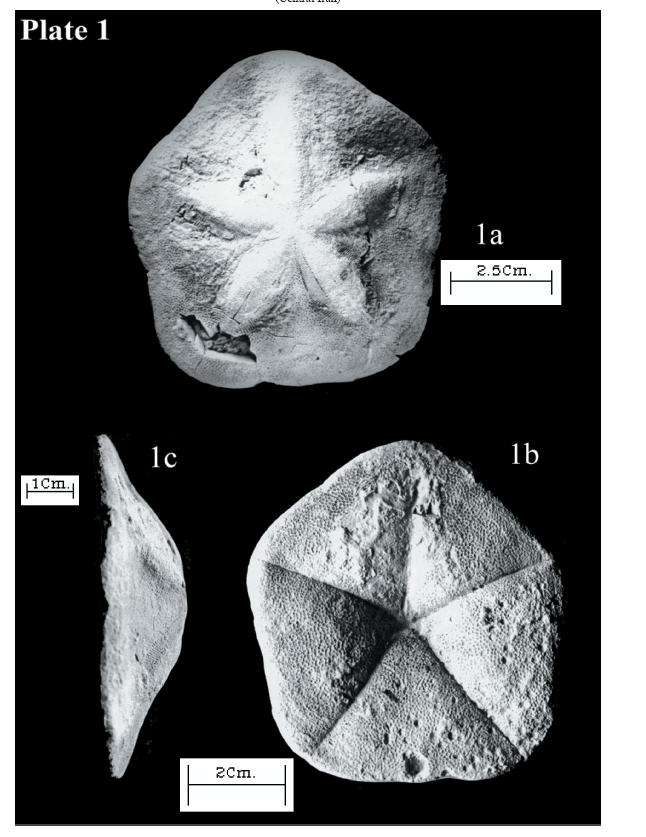
Plate 2
1- Scutella subrotundus (LESKE). Aquitanian, Do Baradar. 3a: C1.8, apical view 3b: C1.11, basal view 3c: C1.11, apical view.
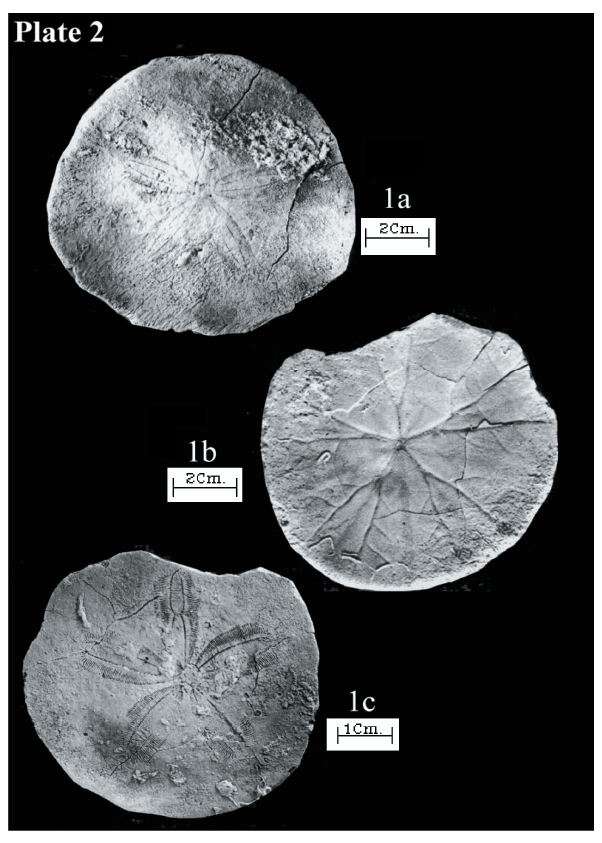
Plate 3
1- Scutella sp. Aquitanian, Eidajti. C1.2, 1a: apical view 1b: oral view.
2- Clypeaster aff. folium MICHELIN. Oligocene, Dochah. A.4. apical view.
3- Echinodiscus balestrai OPPENH. Oligocene, Dochah. A.5, 2a: apical view 2b: lateral view.
4- Amphiope bioculata (DESMOULINS). Burdigalian, Eidajti. C3.19, apical view.
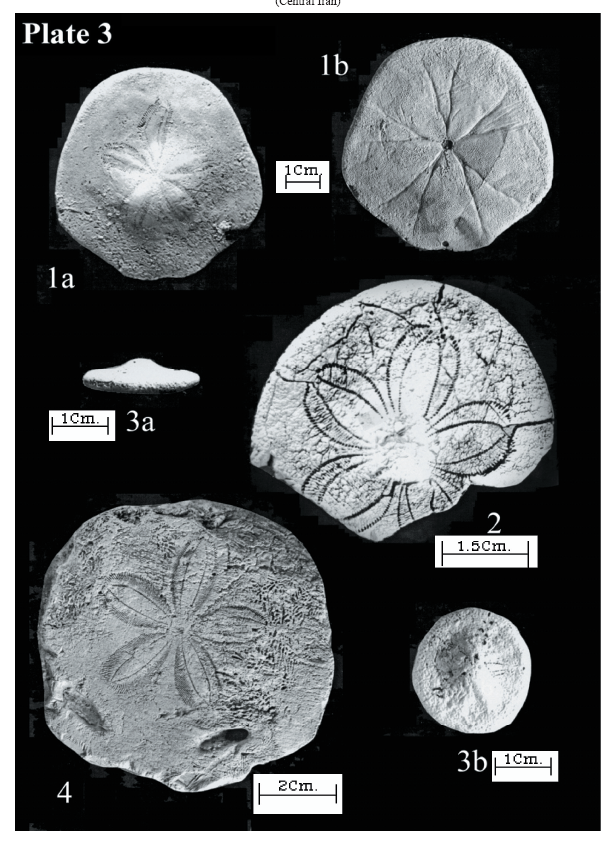
Plate 4
1- Echinolampas cfr. vilanovae COTTEAU. Burdigalian, Kamar Kuh. 5a: C3.a8, apical view 5b: C3.a8, lateral view 5c: C3.a10, apical view.
2- Maretia aff. aragonensis COTTEAU. Lower Miocene, Bichareh. C1.3, 6a: apical view 6b: lateral view.
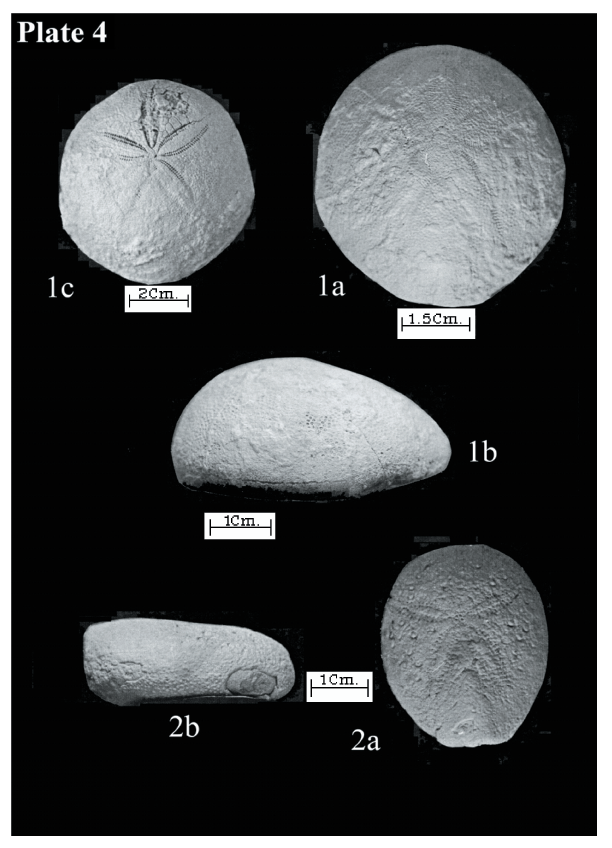
Plate 5
1- Echinolampas (Macrolampas) discus DESOR. Aquitanian, Eidajti. C1.15, 1a: apical view 1b: lateral view.
2- Schizaster aff. vilanovae COTTEAU. Aquitanian, Jorabad. C1.14, 4a: apical view 4b: lateral view.
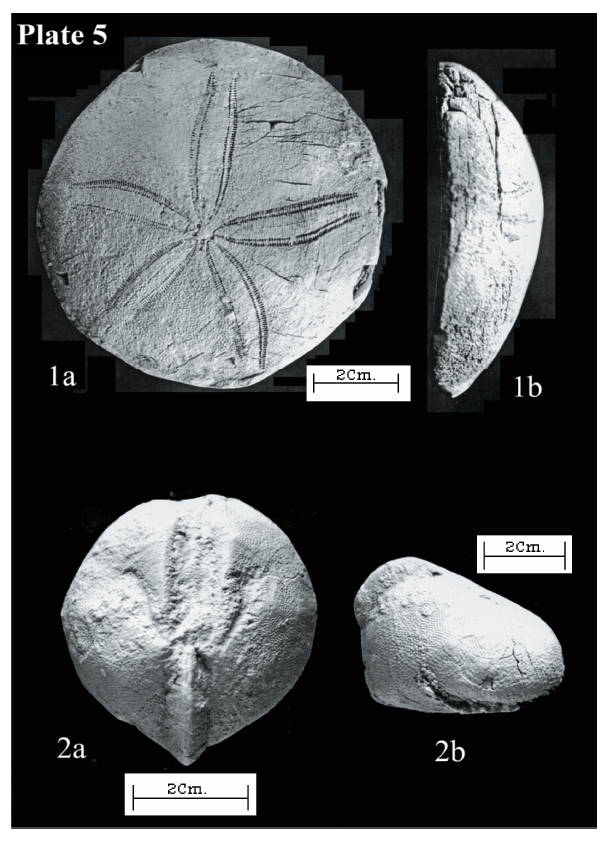
Plate 6
1- Schizaster cfr. beloutschistanensis D`ARCHIAC y HAIME. Burdigalian, Navab. 2A: C3.4, apical view 2B: C3.5, apical view 2c: C3.4, posterior view.
2- Clypeaster biarritzensis COTT. var. trotteri GREGORY. Aquitanian, Shurab. A.3, apical view.
3- Prionocidaris sismondai (MAYER). Burdigalian, Jorabad. E.6, fragment, lateral view.
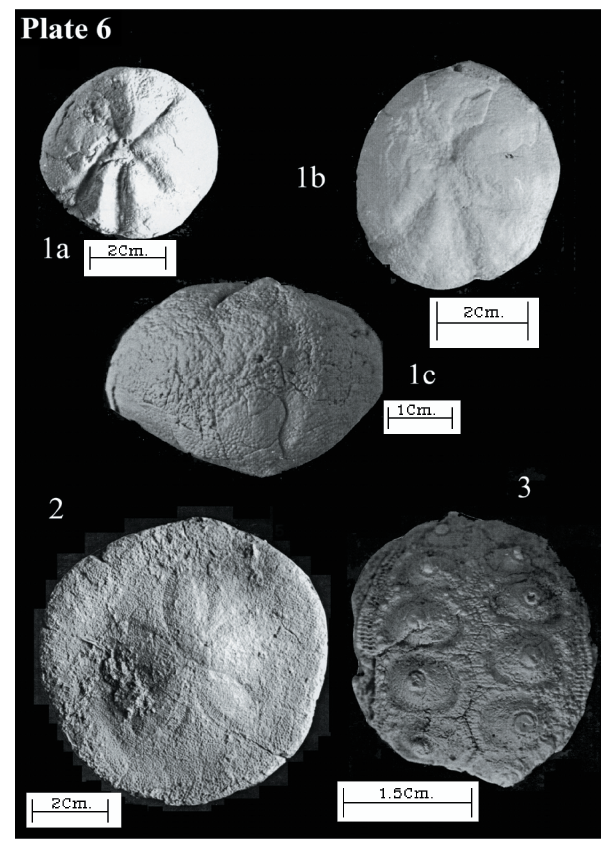
Plate 7
1- Spatangus corsicus DESOR. Burdigalian, Nardaghi. 3a: C4.12, apical view 3b: C4.12, lateral view 3c: C4.13, apical view.
2- Psammechinus affinis FUCHS. Burdigalian, Shurab. C3.4, 3a: oral view 3b: lateral view.
3- Micropsis aff. tremadesi COTTEAU. Aquitanian, Eidajti. C1.13, 4a: oral view 4b: lateral view.
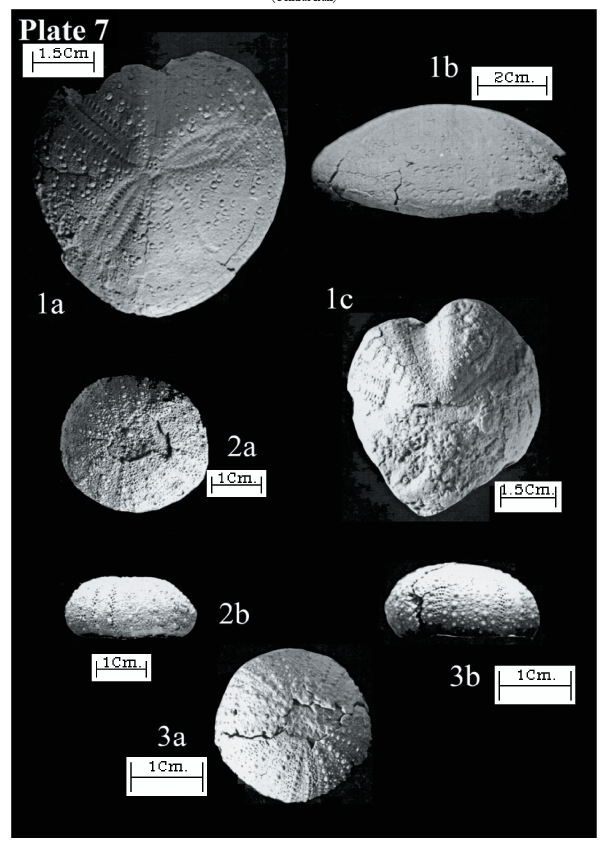
Plate 8
1- Lovenia (Vascoaster) sulcatus (HAIME).Burdigalian, 1a: C3.4, Do Baradar, apical view 1b: C3.14, Nardaghi, apical view 1c: C3.14, Nardaghi, lateral view.
2- Breynia aff. australasiae (LEACH). Aquitanian, Kamar Kuh. C1.19, 2a: apical view 2b: lateral view.
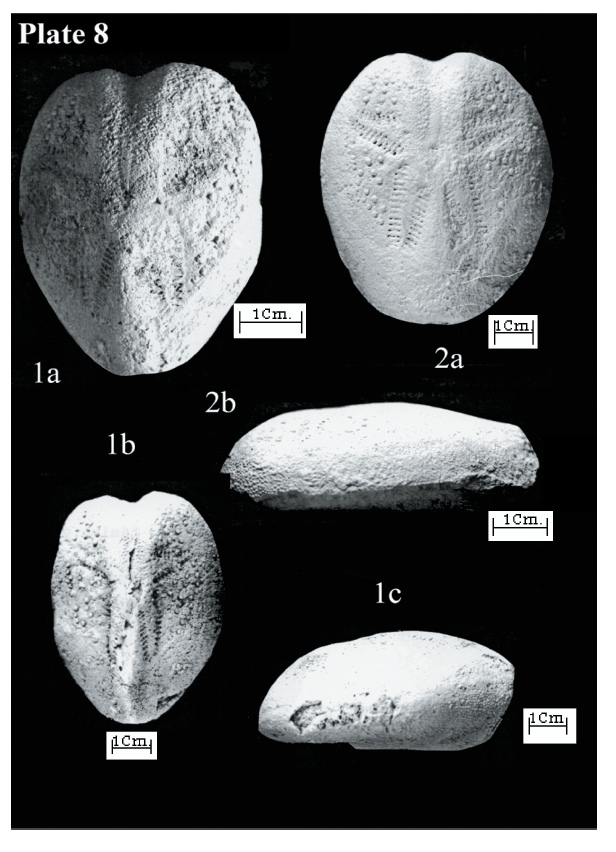
Plate 9
1- Individuals of the Clipeaster and Echinolampas in life position (Sub-Member C1), Eidajti.
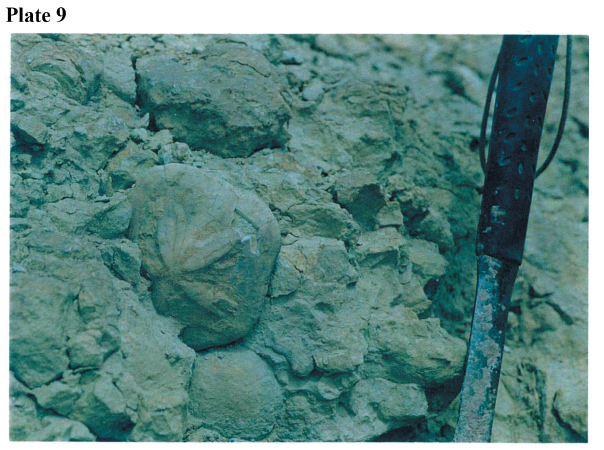
REFERENCES
1. Agassiz, A. (1863). List of the echinoderms sent to different institutions in exchange for other specimens, with annotations. Bull. Mus. Comp. Zool., Harv. Univ. 1 (2). 17-28 [ Links ]
2. Agassiz, A. (1863). Synopsis of the echinoids collected by Dr W. Stimpson on the North Pacific Exploring Expedition, under the command of Captains Ringgold and Rodgers. Proc. Acad. Nat. Sci. Phila. 15. 352-360. [ Links ]
3. Agassiz, L. (1836). Prodrome d'une monographie des radiaires ou Echinodermes. Mém. Soc. Sci. Nat. Neuchâtel 1. 168-199 [ Links ]
4. Agassiz, L. (1840). Catalogus Ectyporum Echinodermatum Fossilium Musei Neocomensis. 20 pages. [ Links ]
5. Agassiz, L. (1841). Monographie d'Echinodermes. Observations sur les Progrès Recéns de l'Histoire Naturelle des Echinoderms. Monograph 1. Neuchâtel. 20 pages. [ Links ]
6. Agassiz, L. and Desor, E. (1846). Catalogue raisonné des familles des genres et des espèces de la Classe de Echinodermes. Ann. Sci. Nat. Zool. 6 (3). 305-374. [ Links ]
7. Airaghi, C. (1901). Echinidi terziari del Piemonte e della Liguria, tav. XIXXXVII [I-IX]. PALAEONTOGRAPHIA ITALICA. 149-218 [ Links ]
8. Alavi, M. (1972). Etude géologique de la région de Dajam. Geological Survey of Iran. 23. 288 pages. [ Links ]
9.Allasinaz, A. (1983). Paleontologia sistematica invertebrati. Ecig, Italia, 377 pages. [ Links ]
10. Archiac, E. (d'.) and Haime, J. (1853). Description des animaux fossiles du groupe nummulitique de l'Inde. 373 pages. 36 pl. Paris. [ Links ]
11. Boltovsky, E. and Wright, R. (1976). Recent foraminifera. Junk, W. Publisher. The Hague. 515 pages. [ Links ]
12. Bosence, D. W. J. (1983). Description and classification of rhodolithes. In. Peryt, T.M. (Ed.): Coated Grains. 217-224, Springer-Verlag, Berlin. [ Links ]
13. Bosence, D.W.J. (1983). The occurrence and ecology of recent rhodoliths. In: Peryt, T.M. (Ed.): Coated Grains. 225-241, Springer-Verlag, Berlin. [ Links ]
14. Bozorgnia, F. (1965). Qom formation stratigraphy of the central basin of Iran. National Iranian Oil Company. 24. 69-76. [ Links ]
15. Buchbinder, B. and Gvirtzman, G. (1976). The breakup of the Tethys Ocean into the Mediterranean Sea, Red Sea, and the Mesopotamian Basin during the Miocene: a sequence of fault movements and desiccation events (abstract). First Congress on the Pacific Neogene Stratigraphy. 32-35. [ Links ]
16. Checchia, G. (1917). Gli Echinidi viventi e fossili della Sicilia. Parte quinta: Echinidi miocenici, tav. V-X [X-XV]. 55-78 pages [ Links ]
17. Clark, H.L. (1946). The echinoderm fauna of Australia, its composition and its origin: Carnegie Inst. Washington Pub. 566. (echinoidea, p.277- 382). [ Links ]
18. Cotteau, G. (1856). Sur les échinides fossiles de la Sarthe. Bull. Soc. Géol. France. 13 (2). [ Links ]
19. Cotteau, G. (1877). Catalogue des Echinides Jurassiques de Normandie. In : Mémoires de la Société Géologique de Normandie. 34 pages. [ Links ]
20. Cotteau, G. (1877). Description des Echinides de la colonie du Garumnien. Annales Sci. géol. 9. 55-72, pl.4-7. [ Links ]
21. Cotteau, G. (1890). Echinides nouveaux ou peu connus. Mém. Soc. Zool. Fr. 3 (9). 537-550. pls 11-12. [ Links ]
22. Cotteau, G. (1891). Echinides fossiles de l'Algérie, Terrains Tertiaires (vol.3, 1885- 1891). [ Links ]
23. Cotteau, G. (1891). Echinides nouveaux ou peu connus. N.S. 10ème part. Mém. Soc. zool. Fr. 4. 623-633. 2 pl. [ Links ]
24. Cotteau, G. (1891). Les échinides éocènes de la Loire-inférieure et de la Vendée. Bull. Soc. Sc. nat. Ouest Fr., 1ère ann. 127-159, 4 pl. [ Links ]
25. Cotteau, G. (1891). Note sur le genre Echinolampas. Bull. Assoc. franç. Avanc. Sc., Congrès Limoges. 337-341. [ Links ]
26. Cottreau, J. (1913). Echinides Néogènes du Bassin méditerranéen. Ann. Inst. Océan. Monaco, t.II. [ Links ]
27. Dames, W. (1878). Die Echiniden der vicentinischen und veronesischen Tertiaerablagerungen. Palaeontog. 25, n°1-2 (1877), 100p., 11 pl. [ Links ]
28. Delanoe, Y., Margerel, J. P., and Pinot, J. P. (1976). En baie de Concarneau, l`Oligocène marin est discordant sur un Eocène ondulé, faillé et érodé, et l`Aquitanien a voilé l'ensemble après une nouvelle pénéplanation. Comptes Rendus de l'Academie des Sciences, Paris, D282, 29-32. [ Links ]
29. Demarcq, G. (1979). Approche de l`evolution thermique au Neogene a partir des invertebres marins Mesogeens. Geobios. 2. 623-627. [ Links ]
30. Demarcq, G. (1984). Bioprovinces et migrations au cours du Neogene en Mediterranee d`apres les megafaunes marines benthiques. Annales Géologiques du Pays Helléniques. 32. 271-280. [ Links ]
31. Demarcq, G. (1984). Importance des megafaunes marins benthiques dans l`evolution paleothermique de la Mediterranee au Neogene. Annales Géologiques du Pays Helléniques. 32. 87-95. [ Links ]
32. Demarcq, G. and Pouyet, S. (1990). Un exemple de paléontologie appliquée: Les enchainements biostratigraphiques et paléobiologiques au Tertiaire. Documents du Laboratoire de Géologie de Lyon. 9. 45-60. [ Links ]
33. Desmoulins, C. (1760-1794). French journalist, revolutionary leader. quoted in The History of the French Revolution, bk. 6, ch. 2, Thomas Carlyle (1837). [ Links ]
34. Desmoulins, C. (1835-37). Etude sur les Échinides. Actes. Soc. Linn. Bordeaux, VII & IX, 520 pages. 3 pl. [ Links ]
35. Desor, E. (1847). Sur quelques oursins fossiles de la Patagonie. Bull. Soc. Géol. Fr., Paris, (2), IV. [ Links ]
36. Desor, E. (1858). Synopsis des Echinides fossiles. 494 pages. 44 pls. [ Links ]
37. Etage Eocène, Miocène et Pliocène. Paris, Masson éd. 273 pages. pl.1-8. [ Links ]
38. Flower, B.P. and Kennett, J.P. (1994). The middle Miocene climatic transition: East Antartic ice sheet development, deep ocean circulation and global carbon cycling. Palaeogeography, Palaeoclimatology, Palaeoecology. 108. 537- 555. [ Links ]
39. Forteau, R. (1920). Catalogue des invertébrés fossiles de l'Egypte représentés dans les collections du Musée de géologie au Caire, terrains jurassiques, part.1, Echinodermes. Geol. Surv. Egypt. Pal. 6. 39 pages, 5 pl. [ Links ]
40. Gómez, J.A.S. (1988). Guía de campo de los fósiles de España y Europa. Omega, Barcelona. 925 pages. 388 lams. [ Links ]
41. Gray, J.E. (1825). An attempt to divide the Echinida or sea-eggs into natural families. Ann. Phil. 26. 423-431. [ Links ]
42. Gray, J.E. (1855). An arrangement of the families of Echinidae, with descriptions of some new genera and species. Proc. Zool. Soc. Lond. 23. 35-39. [ Links ]
43. Gray, J.E. (1855). Catalogue of the Recent Echinida, or Sea Eggs, in the Collection of the British Museum. Part 1.- Echinida Irregularia. London, British Museum. 69 pages. 6 pls. [ Links ]
44. Gregory, J.W. (1911). The fossil Echinidea of Cyrenacia. Quart. Journ.Geol. Soc. 67. [ Links ]
45. Imbesi, M. (1958). Clipeastri Aquitaniani, Elveziani e Tortoniani della Calabria, tav. IXXII [I-XXII], 2 fig. PALAEONTOGRAPHIA ITALICA. 47 pages. [ Links ]
46. Kalantari, A. (1981). Iranian fossils. National Iranian Oil Company. 9. 216 pages. 81 lams. [ Links ]
47. Lamarck, J.B.P.A. (1801). Système des Animaux sans Vertèbres. Paris. 432 pages. [ Links ]
48. Lamarck, J.B.P.A. (1816) Histoire naturelle des animaux sans vertèbres, présentant les caractères, généraux et particuliers de ces animaux, leurs distribution, leurs classes, leurs familles, leurs genres et la citation synonymique des principales espèces qui s'y rapportent. Paris, 1ère edition. 3. 586 pages. [ Links ]
49. Lambert, J. (1906). Sur quelques Spatangidae de l'Eocène d'Egypte, par R. Fourtau. Rev. Paléozool. 10. 184-185. [ Links ]
50. Lambert, J. (1915). Révision des échinides fossiles du Bordelais, Partie II : Echinides de l'Oligocène, Act. Soc. Linn. De Bordeaux, tome 69, 46 pages, 1 planche. [ Links ]
51. Lauriat, A., Brebion, P., Cahuzac, B., Chaix, C., Ducasse, O., Ginsburg, L., Janin, M.C., Lozouet, P., Margerel, J.P., Nascimento, A., Pais, J., Poignant, A, Pouyet, S., and Roman, J. (1993). Palaeontological data about the climatic trends from Chattian to Present along the Northeastern Atlantic frontage. Ciencias da Terra. 12. 167- 179. [ Links ]
52. Leach, W.E. (1815). The Zoological Miscellany. Vol. 2. 162 pages. pls 61-120. [ Links ]
53. Leske, N.G. (1778). Additamenta ad Jacobi Theodori Klein Naturalem Dispositionem Echinodermatum et Lucubratiunculam de Aculeis Echinorum Marinorum. Lipsiae. [ Links ]
54. Less, A. (1975). Possible influence of salinity and temperature on modern shelf carbonate sedimentation. Marine Geology. 19. 159-198. [ Links ]
55. Llompart, C. (1983). Amphiope bioculata del Mioceno de Port de Mao (Menorca). Boletín Real Sociedad Española de Historia Natural. 81. 67-79. [ Links ]
56. Menesini, E. (1967). Gli echinidi Miocenici delle'Arenarie di Pisano (Pisa). Palaeontographia Italica. 62. 143-165. [ Links ]
57. Michelin, H. (1861). Monographie des Clypeaster fossiles. Mém. Soc. Géol. France, Paris, (3), VII. [ Links ]
58. Michelin, H. (1862). Annex A. Echinides et Stellerides. pp. 1-7, pls 14-16(1) in Maillard, L. Notes sur l'Île de la Réunion (Bourbon). Paris : Palais Royal, Galerie D'Orléans. [ Links ]
59. Minnery, G.A., Rezak, R., and Bright, T.J. (1985). Depth zonation and growth of crustose coralline algae: Flower Garden Banks, NorthWestern Gulf of Mexico. In Toomey and Nitecki, M.H. (Eds.): Paleoalgology: Contemporary Research and Applications. 237- 246. Springer-Verlag, Berlin. [ Links ]
60. Moore, R. C. (1969). Addendum-occurrence of Cibolocrinus seminolensis Strimple, n. sp., in southern Kansas. In Fossil Crinoid Studies: University of Kansas Paleontological Contributions, Paper 42, no. 1, p. 6-7. [ Links ]
61. Moore, R. C. (1971). Treatise on Invertebrate Paleontology, Part T pars, Echinodermata 4, Crinoidea. Geol. Soc. America & Univ. of Kansas Press. 816-927 pages. [ Links ]
62. Moore, R.C. (1966). Treatise on Invertebrate Paleontology. Part U. Echinodermata 3. Asterozoa-Echinozoa. Kansas : Geological Society of America and University of Kansas Press Vol. 1 & 2 pp. U1-U695 figs 1-534. [ Links ]
63. Mortensen, T. (1948). A Monograph of the Echinoidea. IV (2). Clypeastroida. Clypeastridae, Arachnoididae, Fibulariidae, Laganidae and Scutellidae. Copenhagen : C.A. Reitzel 471 pages. 258 figs 72 pls. [ Links ]
64. Mortensen, T. (1948). New Echinoidea (Cassiduloida, Clypeastroida). Preliminary notice. Vidensk. Medd. Dan. Naturhist. Foren. 111. 67-72. [ Links ]
65. Mortensen, T. (1950-51). A Monograph of the Echinoidea. V (2). Spatangoida. II. Amphisternata II, Spatangidae, Loveniidae, Pericosmidae, Schizasteridae, Brissidae. Copenhagen : C.A. Reitzel 593 pp. 286 figs 64 pls. [ Links ]
66. Oppenheim, P. (1902). Revision der tertiären Echiniden Venetiens und des Trentino, unter Mittheilung neuer Formen. Zeitschr. deutsch. geol. Ges. S4. 159-283. 23 fig., 3 pl. [ Links ]
67. Palaeont. ital. 25. 127-171. 2 pl. [ Links ]
68. Ramsay, E.P. (1890). Catalogue of the Echinodermata in the Australian Museum. Part 1. Echini, Desmoticha and Petalosticha. Australian Museum, Catalogue No. 10. Sydney : Government Printer 2nd Edn 59 pp. 4 pls. [ Links ]
69. Reijers, T.J.A. and Ten Have, A.H.M. (1983). Ooid zonation as indication for environmental conditions in a Givetian- Frasnian carbonate shelf- slope transition. In Peryt, T.M. (Ed.): Coated Grains, 188-198. Springer-Verlag, Berlin. [ Links ]
70. Shearer, C., Morgan, W., and Fuchs, H. M. (1913). On the experimental hybridization of echinoids. Philosophical Transactions of the Royal Society of London. 204. 255-362. [ Links ]
71. Smedile, M.I, (1958). Clipeastri Aquitaniani, Elveziani e Tortoniani della Calabria. Palaeontographia Italica. 23. 1-47. lams. I-XX. [ Links ]
72. Stefanini, G. (1919). Fossili del Neogene veneto. Parte 2. Brachiopoda-Echinodermata. Stefanini, G. (1939). Molluschi del Giuralias della Somalia, Parte II. 103-268, tav. XIIIXXVII [XIV-XXVIII]. PALAEONTOGRAPHIA ITALICA. [ Links ]
73. Stefanini, G. (1939). Molluschi del Giuralias della Somalia, Parte II. 103-268, tav. XIIIXXVII [XIV-XXVIII]. PALAEONTOGRAPHIA ITALICA. [ Links ]
74. Steininger, F.F., and Rogl, F. ( 1984). Paleogeography and palinspastic reconstrution of the Neogene of the Mediterranean and Paratethys. In Dixon, J.E and Robertson, A.H.F. (Eds.): The Geological Evolution of the Eastern Mediterranean, 659-668. Springer-Verlag, Berlin. [ Links ]
75. Taramelli, T. (1868-1869). Sopra alcuni Echinidi cretacei e terziarU del Friull. Atti real. Ist. Veneto Se. Lett. Arti, (3), 14, 2140-2178, 2 pl. [ Links ]
76. Tehrani, J.J. (1989). Stratigraphy of Iran and type sections of formations. Universidad de Teheran, 1977, 342 pages . [ Links ]
77. Turek, V., Marek, J., and Benes, J. (1988). La Gran Enciclopedia de los Fosiles. Artia, Praga, 520 pages. [ Links ]
78. Venzo, S. (1935) I:Fossili del Neogene Trentino, Veronese e Bresciano, II: Cefalopodi, Gasteropodi, Scafopodi, Echinidi e Celenterati- Conclusioni. Palaeontographia Italica. 35. 201- 255. pl.17-19. [ Links ]
79. Zeng, Y.F., Lee, N.H., and Huang, Y.Z. (1983). Sedimentary characteristics of oolitic carbonates from the Jialing- Jiang formation (lower Triassic), South Sichuan Basin, China. In Peryt, T.M. (Ed.): Coated Grains. 176-187, Springer- Verlag, Berlin. [ Links ]















